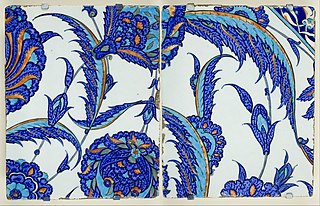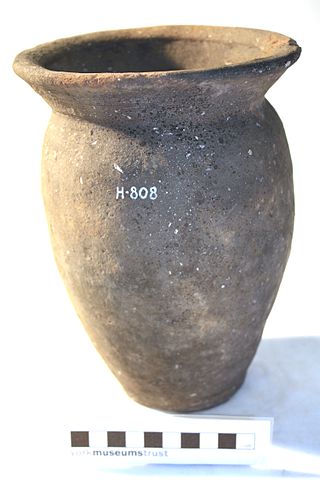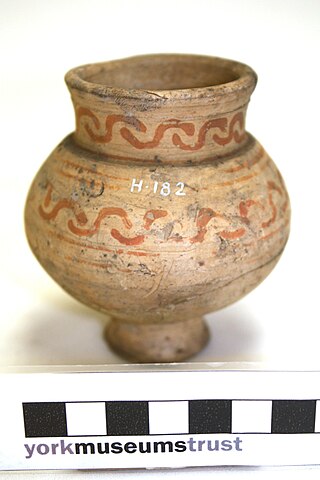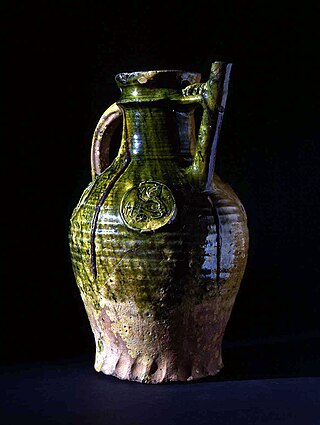
Pottery is the process and the products of forming vessels and other objects with clay and other raw materials, which are fired at high temperatures to give them a hard and durable form. The place where such wares are made by a potter is also called a pottery. The definition of pottery, used by the ASTM International, is "all fired ceramic wares that contain clay when formed, except technical, structural, and refractory products". End applications include tableware, decorative ware, sanitary ware, and in technology and industry such as electrical insulators and laboratory ware. In art history and archaeology, especially of ancient and prehistoric periods, pottery often means vessels only, and sculpted figurines of the same material are called terracottas.

Terra sigillata is a term with at least three distinct meanings: as a description of medieval medicinal earth; in archaeology, as a general term for some of the fine red Ancient Roman pottery with glossy surface slips made in specific areas of the Roman Empire; and more recently, as a description of a contemporary studio pottery technique supposedly inspired by ancient pottery. Usually roughly translated as 'sealed earth', the meaning of 'terra sigillata' is 'clay bearing little images', not 'clay with a sealed (impervious) surface'. The archaeological term is applied, however, to plain-surfaced pots as well as those decorated with figures in relief, because it does not refer to the decoration but to the makers stamp impressed in the bottom of the vessel.

Bucchero is a class of ceramics produced in central Italy by the region's pre-Roman Etruscan population. This Italian word is derived from the Latin poculum, a drinking-vessel, perhaps through the Spanish búcaro, or the Portuguese púcaro.

Iznik pottery, or Iznik ware, named after the town of İznik in Anatolia where it was made, is a decorated ceramic that was produced from the last quarter of the 15th century until the end of the 17th century. Turkish stylization is a reflection of Chinese Porcelain.

Pottery and ceramics have been produced in the Levant since prehistoric times.

Pottery was produced in enormous quantities in ancient Rome, mostly for utilitarian purposes. It is found all over the former Roman Empire and beyond. Monte Testaccio is a huge waste mound in Rome made almost entirely of broken amphorae used for transporting and storing liquids and other products – in this case probably mostly Spanish olive oil, which was landed nearby, and was the main fuel for lighting, as well as its use in the kitchen and washing in the baths.

Dales ware is a type of pottery produced in the South Yorkshire and Lincolnshire areas of England and widely distributed across northern Britain during the 3rd and 4th centuries AD.

Crambeck Ware is a type of Romano-British ceramic produced in North Yorkshire primarily in the 4th century AD.

York Glazed Ware is a type of Medieval ceramic produced in North Yorkshire, England in the 12th and 13th centuries AD.

Brandsby-type Ware is a type of Medieval ceramic produced in Brandsby, North Yorkshire, England, in the 13th and 14th centuries AD.

Humber ware is a type of Medieval ceramic produced in North Yorkshire, England in the late 13th to early 16th Centuries AD.

Ceramic art is art made from ceramic materials, including clay. It may take varied forms, including artistic pottery, including tableware, tiles, figurines and other sculpture. As one of the plastic arts, ceramic art is a visual art. While some ceramics are considered fine art, such as pottery or sculpture, most are considered to be decorative, industrial or applied art objects. Ceramic art can be created by one person or by a group, in a pottery or a ceramic factory with a group designing and manufacturing the artware.

Sandy ware, also known as Early Medieval Sandy ware, is a type of pottery found in Great Britain from the sixth through the fourteenth centuries. The pottery fabric is tempered with enough quartz sand mixed in with the clay for it to be visible in the fabric of the pot. Sandy ware was commonly used in Southeast England and the East Midlands.

Shelly ware, is a type of pottery found in Great Britain from the seventh through the twelfth centuries. Shelly ware includes Late Saxon Shelly ware, Early Medieval Shelly Ware, and Lincolnshire Shelly Wares. The pottery fabric is tempered with shell powder or reduced shell. Shelly ware was typically handmade until the tenth century, when potters transitioned to wheel-thrown pottery. Shelly wares were manufactured and distributed in the Upper Thames Valley, southeastern coastal areas of Britain and the East Midlands.

Ancient Egyptian pottery includes all objects of fired clay from ancient Egypt. First and foremost, ceramics served as household wares for the storage, preparation, transport, and consumption of food, drink, and raw materials. Such items include beer and wine mugs and water jugs, but also bread moulds, fire pits, lamps, and stands for holding round vessels, which were all commonly used in the Egyptian household. Other types of pottery served ritual purposes. Ceramics are often found as grave goods.

Surrey whiteware or Surrey white ware, is a type of lead-glazed pottery produced in England from the 13th to the 16th centuries. The white-fired sandy earthenware was produced largely from kilns in Surrey and along the Surrey-Hampshire border. Surrey whitewares were the most commonly used pottery in London during the late medieval period. There are four classes of Surrey whiteware: Kingston-type, Coarse Border ware, Cheam whiteware and Tudor Green ware.

Border ware is a type of post-medieval British pottery commonly used in the South of England, London and then later in the early American colonies beginning in the sixteenth and ending in the nineteenth century with a height of popularity and production in the seventeenth century. The lead-glazed, sandy earthenware was produced from kilns along the border between Hampshire and Surrey. There are two classes of Border ware, fine whitewares and fine redwares.

Shelly-sandy ware(SSW) is a type of medieval pottery produced in Great Britain. The pottery fabric is tempered with both sand and shell, most commonly quartz sand and ground-up shell. The fabric is generally dark grey in colour with brown oxidised surfaces. SSW was typically handmade until the potters transitioned to wheel-thrown pottery production. The pottery was manufactured and distributed primarily from 1140—1220 AD in the Greater London area.

Ipswich ware is a type of Anglo-Saxon pottery produced in Britain between the eighth and ninth centuries AD. Manufactured in the Ipswich, Suffolk area, it is considered to be the first wheel-turned and mass-produced pottery in post-Roman Britain. The pottery is a simple, hard grey ware with little or no decoration. Most vessel types include jars, cooking pots and decorated pitchers. Ipswich ware was distributed primarily in eastern Britain, but was also traded in smaller numbers from Kent north to York and west to Oxfordshire.

Thetford ware is a type of English medieval pottery mass-produced in Britain between the late ninth and mid twelfth centuries AD. Manufactured in Norfolk and Ipswich, Suffolk, the pottery has a hard, sandy fabric, and is generally grey in colour. Most vessel types include cooking pots, bowls, jars, pitchers, and lamps.
 [4]
[4]  [5]
[5]  [6]
[6]  [7]
[7]  [8]
[8]  [9]
[9]  [1]
[1]  [10]
[10]  [12]
[12]  [13]
[13]  [14]
[14]  [15]
[15] 


















